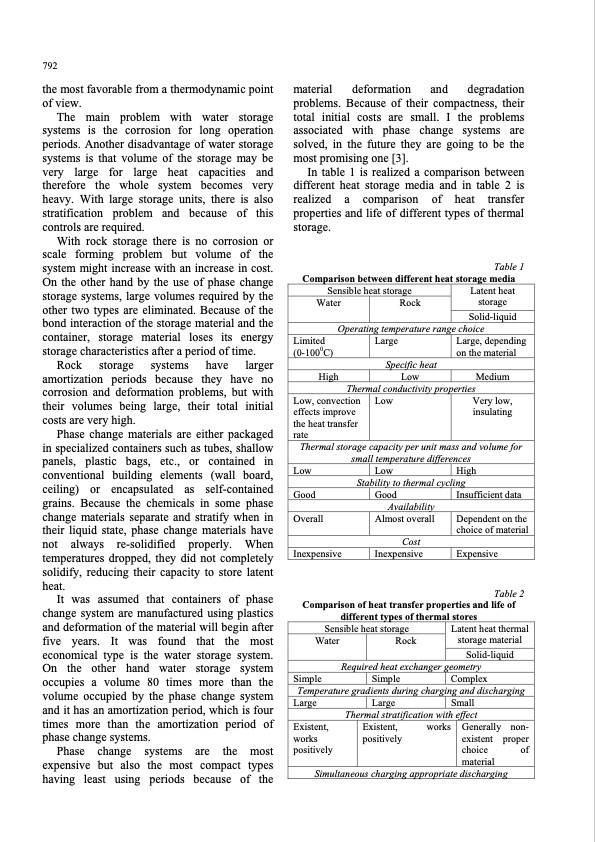
PDF Publication Title:
Text from PDF Page: 009
792 the most favorable from a thermodynamic point of view. The main problem with water storage systems is the corrosion for long operation periods. Another disadvantage of water storage systems is that volume of the storage may be very large for large heat capacities and therefore the whole system becomes very heavy. With large storage units, there is also stratification problem and because of this controls are required. With rock storage there is no corrosion or scale forming problem but volume of the system might increase with an increase in cost. On the other hand by the use of phase change storage systems, large volumes required by the other two types are eliminated. Because of the bond interaction of the storage material and the container, storage material loses its energy storage characteristics after a period of time. Rock storage systems have larger amortization periods because they have no corrosion and deformation problems, but with their volumes being large, their total initial costs are very high. Phase change materials are either packaged in specialized containers such as tubes, shallow panels, plastic bags, etc., or contained in conventional building elements (wall board, ceiling) or encapsulated as self-contained grains. Because the chemicals in some phase change materials separate and stratify when in their liquid state, phase change materials have not always re-solidified properly. When temperatures dropped, they did not completely solidify, reducing their capacity to store latent heat. It was assumed that containers of phase change system are manufactured using plastics and deformation of the material will begin after five years. It was found that the most economical type is the water storage system. On the other hand water storage system occupies a volume 80 times more than the volume occupied by the phase change system and it has an amortization period, which is four times more than the amortization period of phase change systems. Phase change systems are the most expensive but also the most compact types having least using periods because of the material deformation and degradation problems. Because of their compactness, their total initial costs are small. I the problems associated with phase change systems are solved, in the future they are going to be the most promising one [3]. In table 1 is realized a comparison between different heat storage media and in table 2 is realized a comparison of heat transfer properties and life of different types of thermal storage. Table 1 Comparison between different heat storage media Sensible heat storage Water Rock Latent heat storage Solid-liquid Operating temperature range choice Limited Large (0-1000C) Specific heat High Low Large, depending on the material Medium Low Good Overall Inexpensive Low High Stability to thermal cycling Thermal conductivity properties Low, convection effects improve the heat transfer rate Low Very low, insulating Thermal storage capacity per unit mass and volume for small temperature differences Good Availability Almost overall Cost Inexpensive Insufficient data Dependent on the choice of material Expensive Table 2 Comparison of heat transfer properties and life of different types of thermal stores Water Simple Rock Sensible heat storage Latent heat thermal storage material Solid-liquid Required heat exchanger geometry Simple Complex Temperature gradients during charging and discharging Large Large Small Thermal stratification with effect Existent, works positively Existent, works positively Generally non- existent proper choice of material Simultaneous charging appropriate dischargingPDF Image | Thermal energy storage overview

PDF Search Title:
Thermal energy storage overviewOriginal File Name Searched:
ThermalEnergyStorage-AnOverview.pdfDIY PDF Search: Google It | Yahoo | Bing
Turbine and System Plans CAD CAM: Special for this month, any plans are $10,000 for complete Cad/Cam blueprints. License is for one build. Try before you buy a production license. More Info
Waste Heat Power Technology: Organic Rankine Cycle uses waste heat to make electricity, shaft horsepower and cooling. More Info
All Turbine and System Products: Infinity Turbine ORD systems, turbine generator sets, build plans and more to use your waste heat from 30C to 100C. More Info
CO2 Phase Change Demonstrator: CO2 goes supercritical at 30 C. This is a experimental platform which you can use to demonstrate phase change with low heat. Includes integration area for small CO2 turbine, static generator, and more. This can also be used for a GTL Gas to Liquids experimental platform. More Info
Introducing the Infinity Turbine Products Infinity Turbine develops and builds systems for making power from waste heat. It also is working on innovative strategies for storing, making, and deploying energy. More Info
Need Strategy? Use our Consulting and analyst services Infinity Turbine LLC is pleased to announce its consulting and analyst services. We have worked in the renewable energy industry as a researcher, developing sales and markets, along with may inventions and innovations. More Info
Made in USA with Global Energy Millennial Web Engine These pages were made with the Global Energy Web PDF Engine using Filemaker (Claris) software.
Sand Battery Sand and Paraffin for TES Thermo Energy Storage More Info
| CONTACT TEL: 608-238-6001 Email: greg@infinityturbine.com | RSS | AMP |